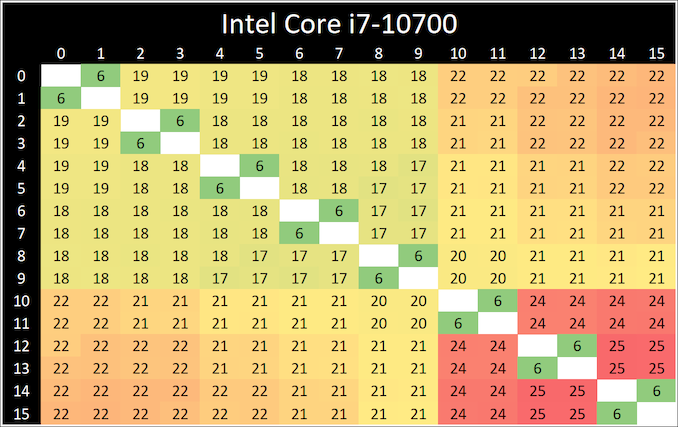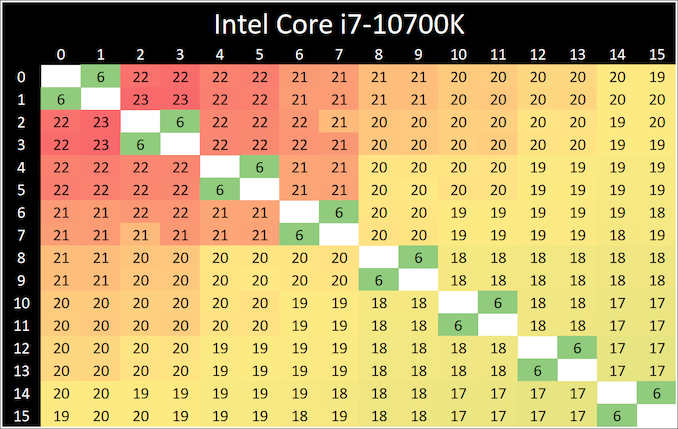Intel Core i7-10700 vs Core i7-10700K Review: Is 65W Comet Lake an Option?
by Dr. Ian Cutress on January 21, 2021 10:30 AM EST- Posted in
- CPUs
- Intel
- Core i7
- Z490
- 10th Gen Core
- Comet Lake
- i7-10700K
- i7-10700
CPU Tests: Microbenchmarks
Core-to-Core Latency
As the core count of modern CPUs is growing, we are reaching a time when the time to access each core from a different core is no longer a constant. Even before the advent of heterogeneous SoC designs, processors built on large rings or meshes can have different latencies to access the nearest core compared to the furthest core. This rings true especially in multi-socket server environments.
But modern CPUs, even desktop and consumer CPUs, can have variable access latency to get to another core. For example, in the first generation Threadripper CPUs, we had four chips on the package, each with 8 threads, and each with a different core-to-core latency depending on if it was on-die or off-die. This gets more complex with products like Lakefield, which has two different communication buses depending on which core is talking to which.
If you are a regular reader of AnandTech’s CPU reviews, you will recognize our Core-to-Core latency test. It’s a great way to show exactly how groups of cores are laid out on the silicon. This is a custom in-house test built by Andrei, and we know there are competing tests out there, but we feel ours is the most accurate to how quick an access between two cores can happen.
When we first reviewed the 10-core Comet Lake processors, we noticed that a core (or two) seemed to take slightly longer to ping/pong than the others. These two parts are both derived from the 10-core silicon but with two cores disabled, and we still see a pattern of some cores having additional latency. The ring on the 8-core parts still acts like a 10-core ring, but it all depends on which cores were disabled.
Frequency Ramping
Both AMD and Intel over the past few years have introduced features to their processors that speed up the time from when a CPU moves from idle into a high powered state. The effect of this means that users can get peak performance quicker, but the biggest knock-on effect for this is with battery life in mobile devices, especially if a system can turbo up quick and turbo down quick, ensuring that it stays in the lowest and most efficient power state for as long as possible.
Intel’s technology is called SpeedShift, although SpeedShift was not enabled until Skylake.
One of the issues though with this technology is that sometimes the adjustments in frequency can be so fast, software cannot detect them. If the frequency is changing on the order of microseconds, but your software is only probing frequency in milliseconds (or seconds), then quick changes will be missed. Not only that, as an observer probing the frequency, you could be affecting the actual turbo performance. When the CPU is changing frequency, it essentially has to pause all compute while it aligns the frequency rate of the whole core.
We wrote an extensive review analysis piece on this, called ‘Reaching for Turbo: Aligning Perception with AMD’s Frequency Metrics’, due to an issue where users were not observing the peak turbo speeds for AMD’s processors.
We got around the issue by making the frequency probing the workload causing the turbo. The software is able to detect frequency adjustments on a microsecond scale, so we can see how well a system can get to those boost frequencies. Our Frequency Ramp tool has already been in use in a number of reviews.
Both processors ramp from idle to full turbo in about six milliseconds, well within a single frame of standard gaming.













210 Comments
View All Comments
bji - Tuesday, January 26, 2021 - link
Then I would appreciate if the O.P. would indicate both what the MSRP is in his country as well as the price that he is quoting availability at so that all the details are known. Since he didn't say the MSRP was any different over there, I just assumed it was the same. It helps to seed the discussion with relevant information at the outset so that we don't have to devolve into useless bickering over unavailable data. I agree that I could have immediately asked what the MSRP was there instead of just assuming it, so that's on me, but even better would have been me not even having to ask.Qasar - Tuesday, January 26, 2021 - link
most of the time, MSRP, is based on US dollarsSpunjji - Wednesday, January 27, 2021 - link
It was safe to assume that, as his reply was in contradiction to yours, £279 was at or near MSRP.bji - Wednesday, January 27, 2021 - link
It is very difficult to get these parts at MSRP in the USA. I think the safer assumption is that it is also difficult to get these parts at MSRP elsewhere.And yet Anandtech will continue to show the USA MSRP in their CPU comparisons as if that is the realistically available price for the part, which is exactly the incorrect information I was trying to rail against when I posted my original comment that started this whole discussion.
Qasar - Thursday, January 28, 2021 - link
but its not incorrect information. the only reason hardware isnt anywhere near MSRP, is due to the fact, that there is more people wanting the hardware, then there are products available. not to mention, that MSRP is for all intents and purposes, constant vs what the prices are in stores.Spunjji - Friday, January 22, 2021 - link
UK RRP is £280. We have VAT and get the British Tax. 🙄Even at £300, I personally wouldn't lose sleep over a retailer taking an extra £20 given the crappy margins they usually get.
bji - Wednesday, January 27, 2021 - link
MSRP includes a mark-up for the retailer to already make the expected profit. A small additional profit is fine; but in the USA what you have is 'scalpers' buying up parts and then trying to resell them for egregious profits. Like a 33% mark-up is the minimum, and until recently 75% - 100% markups were the norm for the Ryzen 5 5600X.Spunjji - Thursday, January 28, 2021 - link
Yeah, I definitely wouldn't buy at those prices. Fortunately I'm in no hurry; the bank account lies empty. 😬drexnx - Thursday, January 21, 2021 - link
I also bought a 5800X at microcenter for MSRP in early December.The "bring up to counter to pick up" sheet they gave me showed they got 75 in on the shipment as well, so it wasn't like it was the one chip they got and I got lucky either...
bji - Thursday, January 21, 2021 - link
Oh my god how many times am I going to have to explain to posters on AnandTech that Micro Center is NOT general availability. They are limited to a few million people who happen to live within driving distance of one of their stores. I wish there was some way to put a disclaimer about Micro Center in my posts without just inviting further debate. I mean the WHOLE REASON that I wrote "general availability" in my comment and put the note about "hard to find vendor" was to try to head of the Micro Center comments, but, apparently, people who shop at Micro Center cannot fathom the idea that 95% of people in the USA do not have access to a Micro Center.